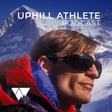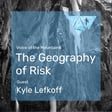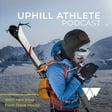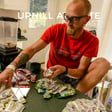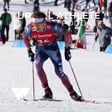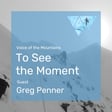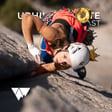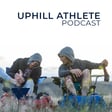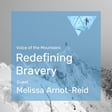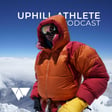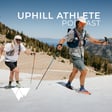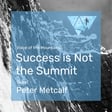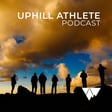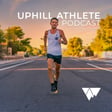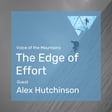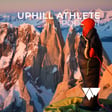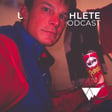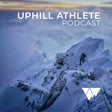Become a Creator today!Start creating today - Share your story with the world!
Start for free
00:00:00
00:00:01

Dr. Olga Dobranowski on balancing training, career, family life...and big mountains.
In this episode, Scott Johnston is joined by Olga Dobranowski. Olga is a medical doctor, based out of Colorado, who has tackled some impressive mountain goals. Here some of the topics discussed: growing up and starting climbing in Poland; Polish climbing history; Olga’s early climbing days in Poland and throughout Europe; moving to the U.S.A., and settling in Colorado; the evolution of Olga’s training; orchestrating success on Aconcagua with a busy lifestyle; pre-acclimatization; light and fast; self-assessment of altitude sickness; continued success on a solo climb of Denali; Olga’s base, aerobic, and specific training; hypoxic tents and other techniques for pre-acclimatization; physiological effects of altitude.
Transcript
Introduction and Resources
00:00:01
Speaker
Welcome to the Uphill Athlete Podcast. These programs are just one of several free services we provide to disseminate information about training for mountain sports.
00:00:10
Speaker
If you like what you hear and want more, please check out our website, uphillathlete.com, where you'll find many articles and our extensive video library on all aspects of training for and accomplishing a variety of mountain goals. You'll also find our forum where you can ask questions of our experts and the community at large. Our email is
Meet the Hosts
00:00:31
Speaker
coach at uphillathlete.com, and we'd love to hear from you.
00:00:36
Speaker
Welcome to another episode of the uphill athlete podcast. I'm your host, Scott Johnston, co-founder of uphill athlete. And with me today is Olga Dombrowski, who has been a sort of loosely affiliated and associated with uphill athlete for several years. Just, you know, I think we've had some email exchanges and I think over, you might've used one of our training plans at one point.
00:01:01
Speaker
And
Balancing Climbing and Life
00:01:02
Speaker
Olga came on my radar really in a couple of these email conversations that we had where she was discussing, you know, some of the things about her professional life and her family life and her climbing life and
00:01:17
Speaker
And I was quite impressed by some of the things that I heard from her and then Olga wrote an article on our website about a solo climb of Denali, which I encourage any of you who are interested in Denali to read.
00:01:32
Speaker
It's a rather novel approach to climbing Denali. You and I may be some of the few people that have ever soloed Denali. We can talk about our shared experiences. But some of the other parts I think that are really fascinating to me and I'm really curious to hear more about is how Olga balances her climbing ambitions and goals and trips that she does
00:02:00
Speaker
as well as her training, along with a very busy family life and her professional life. Olga is a medical doctor in Denver. And I think that this is obviously a very, especially right now with COVID, that is a, I'm sure, a really challenging
Olga's Climbing Beginnings
00:02:19
Speaker
time for you. And maybe you can talk about how climbing and training had to take a bit of a backseat lately or this past year. But
00:02:28
Speaker
I hope we can have, and I'm sure we will, have a really fun conversation around all these aspects. So Olga, welcome. Thanks for joining me. Hi, Scott. Thank you so much for having me. Well, I think let's start at the beginning. I know you're from Poland, and I know that you got started pretty darn early on this trajectory in the mountains. So why don't you give us a little background on that stuff?
00:02:58
Speaker
Yes, so I was born in Poland in Krakow and I'd like to think that I almost grew up in the mountains because not very far from Krakow, my grandma used to have a house which still is within our family because my parents moved there on their retirement and that's in Zakopana, so that's a capital of Tetra National Park and that's especially where I spend
00:03:23
Speaker
all my childhoods, weekends, holidays and vacations, summer vacation, winter vacation. This is where I started hiking and
00:03:31
Speaker
discovering the mountains. This is where I put my first steps in skis. And yeah, my dad was my first ski coach. Interestingly enough, he no longer skis due to any injury, but he introduced me to skiing. He introduced me to mountains. And I think age of eight, I try to remember, by age of eight, I hiked every single trail.
00:03:58
Speaker
there was official trail in Tetra National Park and I think that just sparked that passion and love for the mountains very early on and very quickly the normal child curiosity
00:04:14
Speaker
led to well what if I step outside of the trail and what if I start some scrambling and how about some rock climbing. My parents of course were not happy about that but that very quickly in my very early teens years led into introducing to climbing. Well and there's a tremendous history of
00:04:38
Speaker
very accomplished Polish climbers and, you know, people like Wojtek Kritika, you know, the Jersey Kukuchka and many, many others and people that aren't familiar. I think to that to the layperson Poland isn't thought of as a hotbed of climbing.
00:04:58
Speaker
because they don't know about it, but certainly during the 70s and 80s, the polls were kind of leading the way, especially on really big, hard, dangerous, like winter sense of K2, that sort of thing. Absolutely.
Climbing Influences and Heroes
00:05:16
Speaker
And so you must have been influenced a little bit by that. Did you have some heroes there?
00:05:20
Speaker
I can't say a little. I think I have to be honest and say a lot. Those were my childhood heroes, and those were our just everyday dinner conversations. The names like Kukurka, Vandarudkiewicz, and Wojtekkurtyka were literally like
00:05:41
Speaker
almost family friends, because we talk about them so much around the dinner table. Van der Uhtkevich was probably one of my early idols. She was the first woman to stand on K2, third woman to stand on the summit of Everest.
00:05:58
Speaker
And she was a woman, so you know, obviously I could relate a lot. But I was only 10 when Wojtekurteka climbed the shining wall. I was 12 when Kukuchka finished all four teams, 8,000-meter peaks as a second person in the world. And those accomplishments were
00:06:22
Speaker
I think they're heavily influenced, my childhood and where I wanted to go. I literally wanted to be one of them. I wanted to be another van der Uhtkiewicz. You know, and I have to say that I, well, I'm older than you are, but growing up, you know, being very active in climbing and older in the 70s and 80s and seeing what these Polish climbers were doing, I was like you. I wanted to be Wojtek Kurtica.
00:06:49
Speaker
And for those in the audience that aren't familiar with this, with the heritage and that kind of amazing period where not only was Poland going through these internal, almost revolution change of government and all that, and people were seeking freedom through the mountains, I'm sure. That's what I gather from reading about those climbers that I've read about.
00:07:18
Speaker
But people that aren't familiar with that, I think it's a fascinating cultural story as well as obviously an inspirational mountaineering stories to read about these guys than anyone who hasn't, isn't familiar with Kurtica's climb on and Robert Showers climb on gachubum for the shining wall.
00:07:36
Speaker
That's one of the great all-time alpine climbing accomplishments. And, you know, has never been repeated. So I think it's, you know, it's right up there, you know, and I think we could put, you know, there's a few other ascents like that. And I would have to say that my business partner might hold, has one of those other ascents on Nanga Parvat.
Climbing Across Europe
00:07:57
Speaker
Steve House and Vince Anderson's climb. But this, you know,
00:08:02
Speaker
You and I share this same love for those people and the inspiration that they brought to, I think, young climbers like yourself and myself who wanted to emulate what they were doing.
00:08:15
Speaker
Yeah, I'm very proud of that heritage. And like I said, it had a very strong influence on me as a child, as a teenager, as a growing, inspiring alpinist. And I think the story is really fascinating. And if anybody is interested, I think Bernadette McDowell did a fantastic job writing a book.
00:08:40
Speaker
about all those climbers from Polish climbers. It's called Climb for Freedom or Freedom Climbers, right? Freedom Climbers, yes. I'm just finishing the book she did on Kurtika right now, which is a great read. But I understand, I haven't started, but I'm going to start soon that the Freedom Climbers, I understand it's even more engaging.
00:09:03
Speaker
Yeah, yeah. And the book of, I read the book about Kortika and I have to say that it resonates with me very well. So it, Wojty Kortika and I share the same kind of vision of the mountain that kind of almost philosophical, almost religious approach to the mountain that it's
00:09:23
Speaker
To me, this is like he is another one of my idols. The more I learn about him, the more impressed I am by the man. He wasn't just a climber. Even though that was his passion, the whole climbing thing, as you said, it was almost a religious experience for him.
00:09:45
Speaker
Yeah, fascinating thing. So how did you make that step then from hiker to climber to rock climber to alpinist? How did that transition work for you? Yeah, so early on I started rock climbing and it was a fascinating time in Poland because we didn't have the rock climbs routes established the way we have right now. In Tatra you had to have a special certificate to be able to
00:10:15
Speaker
to climb and I was not 18, so I was not allowed to take a test and my parents did not agree for me to take a test. I had to wait until my 18th birthday. I had all the prerequisites done. I was already climbing, but I was not able to take that final exam and on my 18th birthday,
00:10:35
Speaker
The majority of my friends just party, and this is the first time you can drink legally alcohol, so that's usually the way they celebrate. Instead of doing that, I called my climbing instructor and I said, I'm 18 today and I can take my test. I can take my altruist exam and that would allow me to go climb. So at the time in Poland, climbing was more difficult and more challenging. I think I mentioned to you that
00:11:03
Speaker
I learned how to climb rock with pitons and by the sound of pitons and everything. That was the time when we started seeing friends as the company came up with our friends' cams. But unfortunately, they were so expensive that that would be an equivalent of several months' salary in Poland to buy one cam.
00:11:25
Speaker
So absolutely not possible. And so a lot of local ice climbing and rock climbing, not in a sense that we understand now. So it was interesting when I eventually moved to Colorado a couple of years ago and I picked up rock climbing again, all of my climbing partners were surprised and shocked that I feel very comfortable
00:11:50
Speaker
leading eyes. I was very comfortable leading eyes and putting screws but yet I felt a little intimidated leading rock because I was not familiar with the more modern gear. Like how do we use those cans?
00:12:06
Speaker
Obviously, that came fast. But yeah, so it's interesting that I kind of learned it backward. It was more of an ice and snow because that was easier and more accessible for me in Tetras. But then I eventually started exploring countries in Europe and growing. I grew up poor and my family was not reached by any means. My parents are teachers or teachers. My mom was a
00:12:34
Speaker
a middle school teacher of biology. And my dad was a college professor of chemistry, but that means no money. So essentially at that time in Poland. So I traveled to all my climbing objectives in Europe by hitchhiking. And I was in high school when I climbed my first time on
00:12:56
Speaker
Matterhorn and Montblanc and Montarosa and Half Dome and all of those, you know, iconic peaks in Switzerland and France, but I had to travel there hitchhiking because I had no money. And oftentimes, for example, when modern climbers in Chamonix, they would just take Teleferique and ascend very quickly. And getting to the summit of Montblanc is really not that of a big deal.
00:13:23
Speaker
you get the teleferic and an hour later you're in a Gudimidi which is 3,800 and only a thousand meter elevation. Well I had to hike all the way from Chamonix because I couldn't afford teleferic.
00:13:38
Speaker
Yeah, excuse me, that is a long way. Yeah, that's quite a ways up there. It's for people that don't know, the Chamonix Valley is at roughly a thousand meters or a little over 3000 feet and the Aguita Bidi or the Cosmicut where people would often spend the night before climbing. And these are things that are accessible with the Telophoric are at roughly, I think about 3500 or no, maybe closer to 4000 meters even.
00:14:07
Speaker
Yeah, I think some of it is 3800. So that's, you know, we're talking about for people thinking in feet, this is roughly almost 10,000 vertical feet that you had to hike, which nowadays, most people ride the telephoric, although the telephorics are closed right now because of the COVID thing. And a lot of the athletes I work with who are based in Chamonix are having to do exactly what you had to do. Yeah, because you were too poor.
00:14:37
Speaker
But in the same time, it was a great experience. And I think by ascending this way, I built quite a bit of fitness and quite a bit of acclimatization. Yes, you would. Yeah. And you were probably camping. Were you staying in hospital? Oh, absolutely. Absolutely. Yeah. I was sleeping in my tent. Yeah. And then you said you spent a little time living in Chamonix. When was that?
00:15:04
Speaker
So during my medical school I went to France and I studied for a year and a half in France and I got transferred to study in Lyon but then I spent my entire summer and like early spring and summer in Chamonix and this was one of the best summer jobs I've ever had.
00:15:25
Speaker
getting paid for living in Chamonix and being able to climb on my days off. And what were you doing
Medical Career and Climbing in Chamonix
00:15:31
Speaker
for work? So to earn my living I worked as a receptionist in a hotel but the primary objective of that summer was to get experience in this small hospital in Chamonix. They had this fantastic program at the time
00:15:48
Speaker
when a physician is part of the search and rescue group. So as a medical student, I was allowed to jump on a helicopter and participate in some of those search and rescues. And Salewa, one of the European companies, designed a special backpack for the physicians to carry medication. So the physicians on the helicopter, even though it's such a short distance, such a short fly,
00:16:15
Speaker
the physician on the helicopter was already administering medication on the scene and then flying the person, the climber immediately back to Chamonix Hospital. So for me, it was a great experience as a medical student, as an aspiring doctor, but also as a climber. Yeah, oh, for sure. I know my first experience in Chamonix, stepping off the train, having ridden the train from Geneva,
00:16:43
Speaker
and just taking one look at those mountains and thinking, oh, I'm in heaven.
00:16:47
Speaker
Yes, yes, and that one summer I think I submitted around 17 times just because every time I had like a day off or I was working a night shift or something like that and the next day I had a couple hours I would literally like run quickly and come back and go back to work again and so great experience. That's no small feat because that's about about 13,000 feet of elevation gain from the valley floor to the summit of
00:17:18
Speaker
Yeah,
Transition to Life in the USA
00:17:19
Speaker
and a few times what I would do, I would hitchhike through the tunnel to get on the Italian side, to Courmayeur, and then ascend from the other side, the Papal route, and then descend back to Chamonix. So kind of up and over from the Italian side. And it was funny how Italians always say, you have to do that. That's the only way to do it because our coffee is much better than the French coffee.
00:17:44
Speaker
Yeah, they're like that, aren't they? Yeah. Very, very provincial in that way. But it's also part of, it's a wonderful thing about being there. And so then what, so how did you make the move to the U.S.? And was that at all, was that involved, did that involve the change of schooling or what brought you here?
00:18:08
Speaker
So I already graduated medical school and I went to work as a doctors without borders. I joined doctors without borders medical mission in Egypt. And then I found myself off of cycle after I returned from Egypt. So I decided instead of waiting, I'm just going to come to the US on a tourist visa and just kind of come and explore. I wanted to come and visit national parks and
00:18:37
Speaker
And I happened to, on my first day, literally on the arrival, meet my husband. He wasn't my husband at the time. He was my boyfriend. I've never met him before, but he was a friend of my friends from Krakow. We were supposed to be in his best friend, married my best friend. And we were both supposed to be in the wedding, but he, after he got his master degree, immigrated to Chicago a few months before me.
00:19:05
Speaker
And so I met him literally at the airport. And so my tourist visa then, I extended my tourist visa then I switched my tourist visa to some other form of visa then to some student visa and then 20 years later and two kids later and a couple of houses together were in Colorado. And I went through all the recertification exams and I'm practicing medicine here.
00:19:32
Speaker
And so that move to Chicago for residency must have been kind of a cultural shock, right? It was interesting because it was very soon after I actually was living in the mountains in Chamonix. I also had a wonderful summer that I spent in Norway just climbing ice and climbing mountains. And then I moved to Chicago.
00:19:59
Speaker
which obviously is a big big big city but no mountains to find and no climbing venue and everybody who I met was intrigued by the move from Poland and asking about how of a cultural shock it must have been to move from Poland to USA and in fact I was laughing it was a cultural shock but not because I moved to USA
00:20:24
Speaker
It was because I moved from the mountains to a big metropolia and I was desperately trying to find some sliver of the mountain. The closest in the winter that I was able to find is Wilmot Mountain, which is really not a mountain.
00:20:40
Speaker
It's essentially a pile of trash covered with like two inches or three inches of dirt. And then a ski resort and ski lift are built on top of it. It takes you three seconds to ski down. I was very unimpressed. But that's literally the closest opportunity to ski from Chicago. Wow. Yeah,
Family and Climbing During COVID
00:21:06
Speaker
well, big difference now.
00:21:09
Speaker
But it sounds like you're very well settled into Colorado and I'm sure you've been active there and climbed a fair bit just locally, haven't you? Yeah, yeah, absolutely. And, you know, especially this year, it was interesting because as for everybody, almost everybody, 2020 is a little different year. All my international trips and all my expeditions got canceled. My race in Switzerland canceled.
00:21:35
Speaker
And so I ended up finding myself just doing road trips with my family, with my kids, kind of everywhere throughout Colorado and Utah, a little bit of Southern Wyoming and Northern Arizona. And I was amazed. We ended up spending close to seven or eight weeks altogether throughout the summer and early fall.
00:21:57
Speaker
Uh, in the car, um, backpacking or, or car camping. Doing lots of stuff, but primarily rock climbing, hiking, backpacking and canoeing and discover amazing places. I, I took my kids on so many 14 hours. Now that's, um, their little competition.
00:22:16
Speaker
who is taking more 14ers and 13ers and some classic Colorado scrambles. So it's the competition between the two of them. But yeah, it's a fascinating and it's really a blessing to be to live in such a place where in my backyard in
00:22:35
Speaker
You know, I live at less than 7,000 elevation feet, but in the same time, within an hour or two hours drive, I can be on 14,000 and be in really pretty mountains. And how old are your boys now? They're 14 and 16. I'm sorry, almost 17. If you ask my older son, he would say, mom, I'm almost 17. And so they're probably getting to the stage, or soon will be at the stage where they can push you a bit.
00:23:06
Speaker
That's already happened. That's already too late. So I have now a hard time picking up with them. It was kind of a fascinating journey to watch when I introduced them to climbing. And just a few days ago, I walked, I looked through the pictures of our first trips and kind of camping, family friendly climbing trips.
00:23:34
Speaker
to either Shelf Road or some other places or Indian Creek. And I watched through those pictures and they're tiny in like baby climbing shoes and whole body harness and helmets that are not even properly fit because they're just helmets are too big. And now, you know, six, seven years forward and they're climbing a lot stronger than I
00:24:00
Speaker
was, am, or I ever will be. So the joke is that even if I quit my job and hire a full-time coach and only climb for the rest of my life, I will not be able to climb at the level that I climb. There's no way. And up until this year, we both were on the climbing team. Climbing also on a competitive level and getting to all those different comps and that
00:24:24
Speaker
regional divisional level, my son once got to nationals. So really, you know, and it seems like it comes without an effort for them. What you and I would probably have to work hard. Really hard and train. It seems like there's just no efforts.
00:24:45
Speaker
It is remarkable how quickly kids gain fitness and skills. They're just in a stage of growth where their nervous system is incredibly plastic and especially young boys are just coming into maturity and have a lot of testosterone and begin to develop really quickly. And if you just channel that in some direction, it doesn't matter whether it's running, skiing, climbing, whatever, they're going to,
00:25:14
Speaker
respond very quickly. And as you know, having had an extensive career as a coach for junior cross country skiers, I can say that there's nothing better for the ego than to coach kids, because it makes you feel like you're a really good coach, because you know, anything you tell them to do almost to make them better than than they are. And you can then sort of go, Oh, look at what amazing job I've done coaching these kids.
00:25:39
Speaker
So it sounds like you've really created a couple of climbing machines there. That's fantastic. For sure, for sure. But on the other hand, for me, it's very disappointing because my older son, the 16-year-old, he doesn't have to run. But if we go for a run, he doesn't have to train. He doesn't have to practice running. And when we go for a run together, I can't keep up with him.
00:26:06
Speaker
So no matter how much I put time into my training, I have to work really hard to barely, barely keep up. And he would turn around and says, mom, you're slow. What's wrong? What's wrong? Are you feeling okay today?
00:26:21
Speaker
Unfortunately, it's only going to get worse. One of my young ski proteges when I was coaching, she went on to become very high levels, ranked fifth in the world overall. During her adolescence, she had a younger brother who she had always been able to beat this younger brother.
00:26:44
Speaker
And finally, when he turned about 14 or 15, he began to beat her. And she came to me and she said, what's wrong with me? Why is he beating me? And I said, you better get used to this because I'm afraid that's what's going to continue to happen. And of course, it did. And she did get used to it. But
00:27:04
Speaker
It's one of the problems in general with comparing yourself to other people, but especially comparing yourself to someone of the other sex or someone of a different age. It's really not a very fair comparison.
00:27:17
Speaker
Yeah, absolutely. And I think from my perspective as a physician, that's also a common experience. A lot of my climbing partners or friends come up and ask me and say, something must be wrong with me. You know, as I used to be so strong, I used to be so fast and
00:27:40
Speaker
I used to do this, those kind of races and those long endurance, and I can't do it anymore. And so they're seeking a
Rapid Climbing Strategies
00:27:48
Speaker
medical advice on what kind of test we need to perform to prove that there is something wrong with me. And they get very upset when I simply say, you know, it's part of aging. And unfortunately, we all get this way. And we have to work much harder over time to accomplish the same goals.
00:28:07
Speaker
You should point them to the podcast I did with Steve on the aging athlete. I get a lot of emails because people know that I'm getting pretty old and they want to know how I'm coping with that, which I have to say it's not the easiest thing to do. But Steve and I did a podcast about what we've been lifelong athletes ourselves
00:28:29
Speaker
and what we've noticed about aging and how we're dealing with it and what some things we know from science about it. So yeah, send them to that podcast. It's actually our most popular podcast. Oh, I have no doubt. Yeah, that must be a popular topic. I think there's a lot of baby boomers and Gen Xers out there now that are hitting that age where, oh my God, I just can't do those things I used to do, or I can't do them as well anyway.
00:28:59
Speaker
Well, let's shift gears just slightly because I think one of the things that I've found fascinating about what you've done is you have, I mean, you've got this obviously a very important family life and you've got a very busy professional career and you're not just a casual climber.
00:29:22
Speaker
you have done some amazing climbs, you know, not necessarily for their technical difficulty, but I think more so because of the speed at which you have done these things. And I know that's probably very partly because you can't take that much time away from family and work.
00:29:44
Speaker
And, but I think there's an awful lot of people in a similar position who, you know, they going on a two month long expedition is out of the question for an awful lot of folks. How have you, first of all, how did you get come up with the idea? And we'll talk about specifically what some of the climbs that you've done this way are, but what spurred you to think about that and how did you come up with that idea? And then how did you orchestrate those, some of those climbs?
00:30:11
Speaker
Sure, sure. So that's an important question in the way I recently in my recent years became a climber and almost like a rapid climbing soloist, if you will. And it kind of happened by accident. It literally happened by chance.
00:30:29
Speaker
And I think I started with a Concagua and that's the climb that is absolutely not a technical, it's just a hike on a very tall mountain. It does carry a fair share of prevalence of altitude sickness for that very matter, for that very reason that a lot of people think of it, oh, this is an easy climb, I can get on it and they just move on the mountain too fast.
00:30:54
Speaker
and they get sick. So the traditional expedition for those who are using guiding companies, it will be a three weeks event. So if you add travel time to South America back and forth, that's like it requires literally a month off. For me, it never was an option. There's no way that I can take a month off of my
00:31:18
Speaker
work and away from the family. So that never was on the reader. However, I asked myself that question. I got involved a lot in
00:31:34
Speaker
wilderness medical society and diploma in mountain medicine. I graduated the diploma in mountain medicine, so that's my additional training. And that's kind of what I do on my free time, you know, advise clients and patients and climbers when they go on elevation.
00:31:50
Speaker
And I also teach a lot of those wilderness medical courses and AWS, et cetera. And so I came across some of those studies. They're small and they're not big data, but about how we can maybe pre-acclimate. What can be done in advance? What can I do at home to kind of get a pre-acclimateization, get a head start? So maybe I don't have to necessarily spend three weeks.
00:32:20
Speaker
And then the next question was, what if I light up my gear? What if I don't necessarily do a traditional expedition style when I have to carry tons of gear up and down the mountain? And I can just go lighter. And by that, I'm moving faster. I'm also using less time on the mountain, so less exposure to any kind of element and altitude and potential for inner sickness.
00:32:47
Speaker
And I just did it as a test. I literally did it as a test. So I came across and you started with Alconcagua then as your test. I literally it was a test. And I thought I have nothing to lose. I'm just going to go there for one week. And if it works, it works. If not, I'm just going to be on the mountain for one week and turn around and come back home. And it's still going to be a great experience and great adventure.
00:33:16
Speaker
But I use that as a test to test my response to sleeping in hypoxic 10, the training that I did before using a specific gear on the mountain and how fast can I move.
00:33:33
Speaker
With all that being said, I knew that I have enough knowledge, medical knowledge, and also on the wilderness and altitude medicine, as well as my own experience that I will recognize where it's no longer safe. So I didn't feel like I was pushing limits into unsafe zone. I knew I was on a popular route, on a hiking essentially trail,
00:34:00
Speaker
uh or it's safe when I'm surrounded by all other climbers and um and if I don't feel well and if I have any signs or symptoms of any altitude sickness I'll just turn around or if I get weathered off I'll just turn around and come back and I think going for a short period of time allows me to have that relaxed approach with no pressure on myself
00:34:25
Speaker
And so on my climbs, I never developed that summit fever that we experienced and we see in other climbers. And I can definitely relate to that. And I can imagine that if you spend your lifetime savings and all the money that you have, and you can only do one expedition for
00:34:48
Speaker
in a lifetime over the next five years and that's Everest and you put all your money and all your effort to go and summit Everest. And if then you're not feeling well or the weather is not perfect, I think there's this internal pressure and the pressure that a lot of climbers put on their shirt paths, on their guides to keep going because it's like either now or never.
00:35:13
Speaker
And I think that's almost counterproductive. And I had the opposite approach. And I said, I'll see how far I can get. And if I don't get to the summit, not a big deal. The mountain is still going to be there. And I'll go back home and to work. But hopefully, I can go come back uninjured and not sick. And so I climb a Concagua in six days from trailhead to trailhead.
00:35:43
Speaker
And in very casual pace, I would say, um, I felt great on the mountain. I didn't have any symptoms of altitude illness. I didn't have obviously in a frostbite or anything, and really felt good. So just kind of a casual pace. And, um, so then when I did a concublo in six days and I thought, well, I never wanted to do Denali because that's another mountain that requires a month off.
00:36:10
Speaker
But what if I do Denali in seven days? And that's what I did. So my next step was to go to Denali. In the meantime, I obviously did a few also rapid climbs in Peru and Ecuador and Bolivia. So I also
Climbing Denali
00:36:27
Speaker
was using some of the South America climbs, but I went to Denali with the same approach. I said,
00:36:35
Speaker
pre-acclimate by using hypoxic tent, I'll continue training my fitness. I'll precisely choose the gear because I wanted to make it a ski descent. So I wanted to ski off the Samit and I obviously was doing that by myself. So, and so that's what I did. So my next climb was Denali in seven days. That was via the West buttress route? Yes.
00:37:02
Speaker
Yeah, I chose the easiest, the most popular route for a reason. Going in the Kravastran solo by myself, when I don't have a partner to rope up, it's
00:37:17
Speaker
in many people's mind as close to suicide as it gets. And you were on skis though, right? I was on skis, correct. So I think the way I mitigate that risk, that hazard is by going early in a season, which has less of a success rate because the temperatures are colder and essentially lower ended and it's much colder. But the mountain is frozen and it's much safer.
00:37:48
Speaker
So I decided that it's safer for me to go early on in the season, you know, at the end of May, rather than mid June, when mountain is nice and warm and very pleasant and much better ski conditions in a lot of the above 14p camp course, but in the same time, the lower mountain become
00:38:07
Speaker
a mining field and reversing that in the middle of the day, even on skis, it's a potential hazard. And so I think that the choice of route for me oftentimes is dictated by, am I doing it solo or do I have partners to rope up? Am I going on skis or that's a climbing route or et cetera. So I was on skis and I carried religiously my skis to the summit.
00:38:34
Speaker
It wasn't for any time saving benefits. The mountain was so frozen that I had to down climb the Autobahn.
00:38:42
Speaker
There was no way I could ski cut it. There was no way to ski the sand. The same for Rescue Valley, which is growing from 17k cam back to 14. It was just a pure ice, literally a vertical ice ring. So I had to reverse and many transitions on that summit push on that summit day where I had to go back to ski and crampons from ski to crampons.
00:39:05
Speaker
That's an interesting story. So for people who aren't familiar with this, let me explain a little bit that traveling on a glacier, as Olga has just said, is fraught with hazard of hidden crevasses, crevasses that are bridged by the snow but the snow isn't thick enough to support your weight.
00:39:23
Speaker
And a huge advantage of traveling on glaciers is to put skis on your feet because then you spread the load out over a much larger area. And in many cases, the skis are long enough, they'll actually bridge much of the crevasse. And so the danger is greatly reduced. I have skied on Denali. I mean, my first ski trip up Denali was 1976. And I've done quite several other trips that way.
00:39:51
Speaker
and I've never had a problem with crevasses when I've been on skis. Then often you'd see people that are on snowshoes, you would see these big holes where they had punched through into a crevasse and luckily for them they were all roped up but it does mean most of the traveling I've done on those glaciers has been without a rope as well even when I have partners because it's just so much faster.
00:40:15
Speaker
And so I think that's just a little bit of reference, a background reference for that. And then also what you're saying about trying to actually ski off the summit. I mean, I get requests and I talk to people all the time and said, yeah, I want to ski Denali. And I'd say, well, there's some great skiing to be had above, like between, let's say, 14 and 16. If you get up into that basin on the west buttress, there's some really nice skiing to be done there in good conditions.
00:40:42
Speaker
But there's never going to be good conditions above that. I've never known of anybody that did anything more than just sort of survival ski to come off the summit. That was absolutely my experience. It was not for the joy of skiing. The joy of skiing that I had was skiing down from 14K camp back to base camp. That was absolutely fun. And I felt like...
00:41:11
Speaker
You know, it was amazing experience, even though I had a heavy backpack with me, but ski down in this beautiful scenery and untouched powder, you know, parallel to just the ski track was just phenomenal. And I saw a lot of parties down climbing, getting off the mountains, on the snowshoes, being miserable, carrying those heavy backpacks down on snowshoes.
00:41:36
Speaker
and I felt so bad for them and so sorry for them because I you know I ski from 14k camp to base camp in a matter of a couple hours stop take pictures and and for breaks um and for them it's sometimes two days two days exactly yeah well how let's talk about your ascent and so you you obviously for people that don't know you fly from the town the little town of talkeetna
00:41:59
Speaker
onto the southeast fork of the Cahilton Glacier just outside of the park boundary where the ski plane drops you off and then you begin, that's where the climb or the trip begins. So how many days did it take you to get to 14 and then what did you do when you got to 14?
00:42:18
Speaker
Yeah, so it took me three days, including the day that I flew in. So immediately after I flew in from Talkitna, I started ascending and then the next day I went to 11 K camp and the third day I got to 14 K camp. So the base camp is essentially around 7,000. The first day there's not much elevation gain. It's just a very long flat, almost flat
00:42:42
Speaker
traverse. And then you kind of ascend to 11 and 14k camp. And typically, again, in that very traditional way, it takes up to a week for most people to reach safely that elevation of 14k camp. And so a lot of the times is they have sleds and they carry half of the gear
00:43:07
Speaker
split between the backpack and the sled to the next camp, catch the gear, come back, sleep lower, the next day carry the most of the gear and move camps, and then use a third day as a recovery or rest day. And it's a very slow, in my mind, almost painful process to carry that much gear. But in the same time, there is obvious risk with moving so quickly
00:43:34
Speaker
because it's not like I moved from another mountain or another, you know, training camp up in the elevation. I went straight from work, straight from working 12-hour shifts in the hospital, flew into Talkitna, and literally the next day started my trip. So I had no real acclimatization other than what I can do at home.
00:43:58
Speaker
And when I was doing this mandatory briefing, especially for solo climbers, it's important mandatory briefing with the park ranger and I happen to have a briefing with the person who knows me and he was one of my instructors on Rainier when I did crevasse rescue as as part of my diploma in mountain medicine, a great guy and.
00:44:21
Speaker
And so he recognized me, he knew my background and yet he's still kind of worried. He said, Olga, I'm really worried if you are planning on being in 14K camp in three days. But anyway, I had my post-oximeter and I keep checking my symptom center.
00:44:40
Speaker
I felt great arriving to 14k camp. I was planning on taking one rest day at 14k camp and then just do a summit push. So my plan was to do a summit push on day five. Unfortunately that didn't work. The bad weather rolled in and I got weathered off for essentially three days. So instead of one rest day I had to spend more time at 14k camp
00:45:05
Speaker
I tried to go up on my skis and it was an absolute zero visibility situation. And I tried to ski the rescue galley on that zero visibility day and not a great idea. I found myself above the Burke trunk and obviously started climbing. At some point I turned around and started descending on skis. And with zero visibility, you have no idea where the crevasses are.
00:45:34
Speaker
And I was using that fish pole technique where you like cast a bright fluorescent red or pink piece of cordial edge on the tip of your ski to kind of lay down on the snow to know exactly where you ski. And I would ski, you know, 15 feet and stop and cast again and ski 15 feet. So absolutely not a day that you would want to be going towards the summit. But then eventually I, the high pressure,
00:46:03
Speaker
system came in and the nice weather was moving in so I decided to do a summit push and I did it in one day. I skipped moving to 17k camp so I did the summit push. I'll ski down the same day I was back in 14k camp and the next day I ski down all the way back to base camp.
00:46:23
Speaker
That's definitely my preferred way to climb that mountain or that route on that mountain. And Steve and I actually have written about that in our training for the New Alpinism book because I think it's safer, honestly, to go from 14 to the summit and back in a day. It's a long, you know, for many people that will be a long day, but you just don't, you're not having to carry a heavy pack to 17.
00:46:48
Speaker
Which for many people is going to exhaust them so badly that the triple essentially be over by the time once they get to 17 and then you know spending a night at 17 is much more challenging in terms of recovery than spending a night at 14.
00:47:04
Speaker
And then to have to get up the next day and perhaps, you know, maybe do go to the highest point you've ever been in your life and maybe even do the hardest thing you've ever done in your life. I just, I feel like the reason that I think that that's popular and that many guide services take that approach is most people who go on those trips are not very fit.
00:47:24
Speaker
And they can't do a 6000 foot day. But the beauty of the 6000 foot approach like you did, and I mean, I've done it several times is you have a 10 pound backpack. Yes, it's the most you know, you've got a water bottle, maybe a little bit of food and a down jacket. And you know, it's a it's a very manageable in your case, of course, you had to carry skis too, which is another 10 pounds or more. But it's a
00:47:50
Speaker
It's a much more manageable thing to do, I think, is when you get above, when you get to those altitudes, carrying a 40 pound, 50 pound pack is incredibly taxing.
00:48:02
Speaker
Yeah, absolutely. Absolutely. And just as a point of reference, I kind of befriended a group at 14K Camp that was professionally guided by Vernte Haas and whom I met before in a great climber, great guide, an author of a book, and you know, someone who, so Vernte Haas is a person who actually
00:48:28
Speaker
I don't know the official count. As of a couple years ago, he summited Denali 56 times and he's the first person who did solo Denali winter ascent. So the first man ever to stand on Denali in winter solo. Very prolific climbing guide, but he guides in a very traditional way. So we met at 14k camp and
00:48:50
Speaker
I befriended them because I didn't have a radio and there's usually a weather forecast in the evening. So I would come up to their tent and listen to the radio weather forecast. And he got very concerned about my plans when I mentioned that I want to move straight from 14K camp and just go light and without moving camps to 17K camp. But then the next day I did it and I came back obviously safely and I was speaking soundly in my tent.
00:49:18
Speaker
Well, for them, for that expedition, it took seven days. From 14 to the summit. From 14 to summit and back. So, you know, on day one, they cashed gear at 17k camp, then came down, slept at 14. The next day, they moved camps. Then the rest day, then one summit attempt that was unsuccessful.
00:49:39
Speaker
they turned around from Denali Pass and then one more attempt and then came down to seven full days. So if you imagine how much effort, how much work, how much poor sleep, higher exposure to higher elevation, how much food you have to carry, how much fuel you have to carry. For me, this is all about
00:50:00
Speaker
risk versus benefits in the mountain. And if I can move fast enough and efficient enough to do it in one day, there's no doubt in my mind that that's the right way to go.
00:50:11
Speaker
Absolutely.
Training for Rapid Ascents
00:50:12
Speaker
When there's the axiom, I think that most people know that speed equals safety in the mountains. And especially those sorts of altitudes. Yeah, that sounds like a grueling thing. I wouldn't want to subject myself to something. Yeah. And I think many people are unprepared for that. I don't know what his success rate is with clients or was on that. I've met Vern once or twice up there. Don't know him really at all other than that.
00:50:39
Speaker
And I do have a tremendous respect for his abilities and his knowledge of the mountain. It's amazing. He spent so much time on it. Excuse me for clearing my throat. But I believe that there is, for people that are fit, it can work really well. I have worked with, years ago, when I was coaching some cross-country skiers, these were college-age skiers who were very fit.
00:51:08
Speaker
but almost no mountaineering experience. And I gave them this, you know, told them where they should camp and how fast they should move. And they, these are guys with young fit men with no climbing experience. And they did that exact same thing. They did Denali in, you know, I think less than 10 days, went from 14 to the summit, had a great time.
00:51:31
Speaker
And so it is doable, but it's the fitness base that makes the difference for people. And I think that's, you know, which is, again, obviously what's the whole foundation of our business is to try to provide that. Before we talk about your use of hypoxic tent, which I think will be interesting for folks, what do you do for training?
00:51:56
Speaker
So, it all depends of a specific objective. Obviously the base training and the aerobic training is pretty much always the same and that's one of the big parts of my regular training. But then on top of that, it all depends on what specific expedition requires. So, for example,
00:52:17
Speaker
Last year when I was getting ready to climb Amadablum and I wanted to do it in Alpine solo style without using fixed ropes, my objective, part of the training objective was to climb as much ice and mix routes as possible and feeling comfortable with being on rope and having just a lot of training and a lot of mileage under my belt.
00:52:43
Speaker
So I think that component varies depending of whether I'm going to pull a sled or no sled, whether this is more of a climbing or this is more of a hauling, heavy backpack, etc. So the bulkiness of my training is running, hiking on the actual mountains, on the actual train.
00:53:05
Speaker
I at least once a week I try to have a one big day in the mountains on the after and then I think this is the best form of the training to whether this is me running in trail running shoes or this is more of a scrambling but being on elevation and covering a lot of ground being familiar with that terrain
00:53:28
Speaker
It's almost like a muscle memory where you simply not just part of the training, but just like how efficiently you move across the terrain. That's the big part of my training. On days that I can't, obviously I can't always be in the mountains and I have to work 12 hour shifts. I often run or do my mini incline with just water jugs.
00:53:54
Speaker
So that's one of the things that I learned from you as part of the muscular endurance is just carry, you know, water jug, uphill carries. And I have a mini incline, that's not a real incline, but it's close enough to the house. It has 200 steps and then followed by some trails.
00:54:11
Speaker
that I use for that purpose and I just run laps and a few days ago now it's getting colder and darker so by the time I finish work and by the time I get there it's usually after dark. So I have to have a headlamp so I always have a headlamp in my car and a backpack and now it's kind of icy so I have to have a microspike and that's my training.
00:54:35
Speaker
And you have, starting at the early age of when you were not even eight years old, you were doing a lot of hiking, having that, one of the things I've noticed, having a lifetime of that type of activity has already given you such a great base. Many of the adaptations that take place to endurance training, they're there for life. And you built them when you were a kid.
00:55:00
Speaker
they will go away, of course, but it's easy to maintain them and to restore them back to what they were. I often say, tell people that what you do through your adolescent years is going to basically set you up from a physical standpoint. Maybe even from a psychological mental standpoint, but in terms of learning and schooling and all that, but certainly from a physical standpoint,
00:55:27
Speaker
the kind of physical activities you engage in through your teenage years are going to have an imprint on your body that will last the rest of your life.
00:55:36
Speaker
Yeah, yeah, absolutely. So I think that my first formal training with you was actually before Aconcagua. I did that 16 weeks program and it was really, really helpful. I immediately saw some gains and I also saw the areas of deficit that very quickly became obvious, but that's what it's for. And I think I was able to turn around that and
00:56:01
Speaker
and got stronger. Before Denali, I kind of modified a few things because up until the very last minute, I wasn't sure if I was going to take a sled or I can just carry everything in my backpack. The challenge with going solo and completely by myself is that I have to carry everything. There's no climbing partner that I share a tent and stoke and some of the group gear with. I have to carry absolutely everything.
00:56:30
Speaker
And I'm not the biggest person. So my body weight is also to some degree limiting how much I can carry in my back. That's a big disadvantage of being a small frame woman. And so when we talk about carrying 75 pounds on my back,
00:56:51
Speaker
relatively to my body weight. It's almost unhealthy, unhealthy weight. So I was very tempted to, for example, consider a sled, because that would help to some degree. And I decided against it. But as part of my training, I was using spare SUV tire that I keep in my garage. And just behind my house, actually, you can see it from my window, there's a little hill and
00:57:18
Speaker
And I would just put my big backpack and my mountaineering boots on, strap a harness and drag the tire and do it over and over and over again. Now, the problem with that is that I live in a really nice neighborhood and it's a gated neighborhood where a lot of nice cars drove by and I have to, I can't tell you how many times people stopped and gave me the second look and wonder if I was okay.
00:57:45
Speaker
Why are you doing this to yourself? I've had that experience too. I think most of the people who train doing the things we do have had that experience in that same vein of training. One of the folks that trained with one of our coaches, this was years ago, they lived in some Iowa or some flat place, completely flat place. And their training, this man, I think was a husband and a wife that did this,
00:58:13
Speaker
their training for Denali, they had a relatively small size lawn tractor, the kind you sit on for mowing your lawn, and they dragged that thing around. They would put it on, and they had some sort of an alleyway or a driveway, and they would take turns harnessing themselves to this little tractor and dragging that.
00:58:34
Speaker
People can get very creative with this kind of thing. I think one of the reasons we put that picture of Steve pulling the tire at Smith Rock in Oregon was to show people that we actually do this kind of thing. It can be part of your training. We don't use it very much anymore.
00:58:54
Speaker
because we found some other ways to work around that and because a lot of people are going to either be intimidated or embarrassed to have to drag a tire in front of other folks.
00:59:06
Speaker
I can definitely relate
Pre-Acclimatization Techniques
00:59:07
Speaker
to that. Let's talk some about your use of the hypoxic tent and how that has worked for you. We've written extensively about hypoxic tents on the website. I have some mixed feelings, but I think I have some qualified
00:59:28
Speaker
I have some qualified reservations about their use, but I'm also an enthusiastic believer in them, especially for the kinds of things you do, which are very short duration where you just don't have time to naturally acclimatize.
00:59:43
Speaker
But so how long did you do you have a routine that you went through on each one of these climbs? Was it the same like the number of nights you spent in the tent? Was it the same or was it did you change from climb to climb? Fairly consistent. I think towards my last climbs last year when I was headed to 7000 meter peak. So when I climb Amadablung and Cantangri last year, it was little
01:00:11
Speaker
longer period because I was aiming for higher sleeping elevation just prior to departure. But I think it kind of was the hypoxic tent was a natural evolution of essentially me sleeping on high Colorado passes, which is the previous technique that I've used and we're blessed enough that we can
01:00:31
Speaker
drive to a Fortuner like Mount Evans for example there's literally a road that takes you all the way to the summit and you can sleep in the car and that's what a lot of climbers do and in a form of acclimatization obviously the best way is to have activity and training on elevation but with work schedule and family I know
01:00:50
Speaker
always have time. So I would sleep on those higher passes and elevation. Unfortunately, they're closed in winter. So some of those are not easily and readily available. So this is where it kind of evoluted towards hypoxic tent. And first time I use it before Aconcagua and before Denali, I start with what I would
01:01:13
Speaker
consider a comfortable sleeping elevation for me which usually is around 11 or 12,000. I'm in the mountains often enough that that altitude as a sleeping elevation starting sleeping elevation feels comfortable. But that would be just a cautionary point here. That would be for people living at sea level that would be much too high for them. Absolutely. Now this is not a starting point for a majority of people. That's
01:01:37
Speaker
That's why I want to clarify that I live at almost 7,000. And so if I, if I, at least once a week, I am on 12, 13 or 14,000 feet, then I'm adapted to that elevation already. Starting elevation for majority people should be really no higher, not much higher than their normal sleeping elevation, and you slowly build up.
01:02:04
Speaker
So, and then every, I would say three, fourth night, I would increase that elevation until I would reach the elevation of my highest predicted camp and until highest sleeping elevation on the mountain objective. And so I am
01:02:23
Speaker
As far as hypoxic tense, there's a couple of things that needs to be said about that. For one is this is absolutely not a magic wand. This is not something that I'm going to rent a tent or buy a tent, sleep in it and forget the training and I don't have to do anything and it's just going to be magically
01:02:40
Speaker
my pre-acclimatization will magically appear. That's not where it's for. I think the way I use it for is to really gain that sense of acclimatization so I can speed up the approach time. So the amount of time, the number of days that it takes me to get to base camp or to camp one or to whatever significant elevation is much shorter. So I can, for example, in Amadeblanc,
01:03:09
Speaker
I, um, I flew into Lukla the same day, uh, went to Namche Bazar. And then on the second day, the third day I was already in Amadeblom base camp. And the very next day I already moved to camp one. So for four days in a row, I was consecutively moving, uh, fairly big elevation gains without feeling altitude. Um, and then in camp one, it was my first.
01:03:37
Speaker
And I think it's really hard to say whether this is anecdotal evidence that it's working on me and a few other climbers that I know and small numbers of trials, mostly military trials.
01:03:54
Speaker
Or this is more of a placebo effect. It's really hard to say. The mechanism is really unknown because, as you know, the basis for our acclimatization when we are on the real mountain and in real environment is a barometric pressure change. And so what we believe is that the drop in barometric pressure somehow triggers the baroreceptors in our carotid arteries.
01:04:17
Speaker
And that triggers that whole cascade of upregulating genes that are responsible for us adapting to that elevation. So that's the first trigger. That absolutely has no place when I sleep in hypoxic tent. I don't change the pressure. I still sleep at the very same barometric pressure with or without a tent.
01:04:38
Speaker
Yes. So these tents are called, they're called normobaric hypoxic environment. So for people that aren't familiar with that, meaning that the pressure is the same as wherever you're living, but hey, just reduce the amount of oxygen in the air. And, excuse me, and I think you maybe, do you know Rob Roach at the University of Colorado? So I think I've talked about him before, but
01:05:05
Speaker
He did a presentation at a conference I was at. Excuse me just a second.
01:05:14
Speaker
Anyway, Rob did a presentation at this conference that I was at about high health. We were, Steve and I were presenting at this International Special Forces Symposium on Winter Warfare. And Rob was one of the speakers there and it was fascinating to hear. I won't go through the whole details of what he studied, but he basically went to altitude with a bunch of young runners and took an entire genetics lab with him.
01:05:40
Speaker
And they found that one quarter of the human genome was affected by the change in altitude, so roughly 5,000 genes, some upregulated and some downregulated. And of those, they only knew what a handful of them did. And so there's a massive, as you pointed out, cascade of effect that's going on there.
01:06:03
Speaker
But one of the most, my layman's knowledge of, and I think probably many people's understanding of how we acclimatize is that we produce more red blood cells, so we have the capability of carrying
01:06:16
Speaker
more oxygen when we're at high altitude. But one of the things that Rob did in this study was the study only lasted for two weeks so that that wasn't enough time for the red blood cell count to go up, much so the hematocrit stayed essentially the same the whole time they were there. But nonetheless, there was a 25% average improvement in performance.
01:06:39
Speaker
between day number one and day number fourteen so something big was are many big things were happening without even any change in the red blood cell count and i found that part kind of mind-blowing i went okay there's so
01:06:55
Speaker
Yeah, so I agree. So I think by now we already all agree and know that this is not our acclimatization is not based on hermatocrit in a sense that there's just not enough time to produce more EPO and EPO producing more red blood cells from the bone marrow. That process might play some role in more of a chronic acclimatization, but that takes time and on average we see that effect after about three weeks. Now I'm not on the mountain
01:07:24
Speaker
for three weeks at a time to even see and benefit from that effect. We do see changes in hematocrit immediately on day one and two, but what it's, this is a reflection of changing in plasma volume. We simply, one of the first response to altitude is we breathe faster. So we developed that alkalosis, respiratory alkalosis, and we start peeing more.
01:07:51
Speaker
often, and that's a common experience that a lot of people see. Once on elevation, we pee more often. It's almost like we're on diuretics, on water peel. And what it means in terms of hematocrit is that it reduces the plasma volume. So yes, we do see increase in hematocrit, but that's not because we produce more red blood cells. It's simply they're more concentrated.
01:08:14
Speaker
So, so I agree. There is a bunch of cascades, um, based on, we exactly don't know what kind of gene are triggered by what and what they're responsible for. Um, that are very different from producing more red blood cells and, uh, an equal protein production. Have you personally with your medical background, have you ever done a test to see how your himatica changed from day one in the tent to the final?
01:08:42
Speaker
So I did not. And the person who convinced me that it's worthless was Peter Hackett, who is one of our very good high altitude specialists and author of many, many chapters and books. And Peter is one of my teachers at wilderness medical society and did all my mountain medicine.
01:09:01
Speaker
And he was one of those people who pointed out that you might not see any results and any changes. And I did have sporadic, it wouldn't be in the consequential, in the sequential testing, but I had sporadic hematocrit chat while sleeping in hypoxic tent and there was no change. So he kind of steered me away from that saying, you might not, this is not the way to measure that.
01:09:31
Speaker
And so I think that the majority of the studies that we have up until now are coming mostly from military. So military folks are very interested in using hypoxic tend or any kind of remedies that would allow, you know, if the soldiers are put in a very harsh environment, let's say in Iran or Pakistan in very high mountains, they can't really stay there for too long. So at some point they have to descend
01:09:56
Speaker
get some rest, refuel, rest, and sleep well. But on reinsertion to the altitude, they've noticed a lot of acute mountain sickness and a lot of hip and haze. And so the question that military folks ask is, what can we do to prevent that from happening? So
01:10:14
Speaker
even the military center on the summit of Pikes Peak is testing a lot of that. And unfortunately, those are all small studies, small trials when a number is, you know, 20, 30. So this is not a compelling evidence like we're used to in medicine, you know, something that in order to call that this is evidence-based medicine, we would have to have a well-randomized study with much larger number of participants
01:10:44
Speaker
And it should be an ideal word, randomized. So you're sleeping in a tent, but you don't know if it's hypoxic or it's normoxic. And that simply can't be achieved because obviously you already know, you know, you feel the symptoms, you wake up with a headache if you crank up your altitude too quickly. And so this is very difficult to obtain. And of course, very, very expensive. So we might never get that amount of evidence that we
01:11:11
Speaker
that we want from the trials and from the studies that we have so far. What we learn is that it has to be done systematically. It has to be for a minimum of seven hours a night and it has to be minimum six nights a week. So
01:11:27
Speaker
you can't really take a break and do it on and off. And it should be seven hours every night. The way I use it is, like I said, I use it to improve my ability to acclimate or acclimate fast, or if you want to call it pre-acclimate. So when I arrive to the mountain, I'm ready to go. I don't have to spend that much time on the lower elevation getting acclimated to that lower elevation.
01:11:56
Speaker
I'm not trying to increase my performance. And they're actually, and I think your point will be that a lot of time there is a counter benefit of that sleeping in a hypoxic tent in the front of that we don't rest and recover as well as sleeping without hypoxia. And that would be a valid point.
01:12:21
Speaker
So what I would say, I think my take on that is that if someone is a professional athlete and they're doing those incredible climbs that requires the extreme level of fitness and performance, but in the same time, they have plenty of time to get to the mountain and acclimate in a traditional way, that's probably not going to work for them.
01:12:46
Speaker
because I think that's going to just hinder the effect of their training prior to the trip, and it's going to be counterproductive overall on their training performance. Now, for me, I'm not a professional athlete. I don't go there to establish a new route, but my goal is to go into significant elevation in short period of time.
01:13:09
Speaker
and then come back home and go back to work. So I think my objective is how can I make sleeping on elevation safer without getting sick and altitude illness. And I think in that respect, sleeping in that tent for nights prior to trip is helpful.
01:13:28
Speaker
Statistically speaking, what we know is that it's decreased the prevalence of acute mountain sickness and it decreases the prevalence of high altitude cerebral edema. It does not prevent you from getting paid.
01:13:43
Speaker
So it has no effect on prevalence or incidence of getting so high altitude pulmonary edema. And like I said, I think my experience is very good. I'm very happy with the results and I keep pushing the elevation that I keep getting to. I haven't
01:14:03
Speaker
reached my breaking point yet. I haven't got to the point that I went on the trip and I felt too sick to continue ascending. Now granted, I have not been on 8,000 meter peak, so that might be a definitely a test, but I'm willing to continue that because I think it still allows me to
01:14:27
Speaker
keep
Hypoxic Tent Use and Its Impact
01:14:28
Speaker
going to work until my very last day, right prior to going on an expedition, continue to be at home with my family, which is really also very important just prior to leaving for a week or 10 days, and also achieving those ascending elevation in much faster pace than most people would consider safe.
01:14:54
Speaker
How long was your total trip on Amadablam from door to door? Eight days. Well, I think it was 11 days, including travel time. From Denver to Denver. Yes, but eight days from Kathmandu.
01:15:10
Speaker
Yeah, well, I concur, I think, with everything you're saying. And I mean, when I said I have a reservation with regards to the use of hypoxic tents, it's basically that, as you pointed out earlier, it's not a silver bullet. It's not a quick fix. And we have found that the training is probably more important, I think, for many people who are not very fit.
01:15:38
Speaker
And where we have seen problems is that people can't balance sleeping in the tent and recovering enough to continue their training. And not only, I'm not talking about just amateurs, one of the best high altitude climbers in the world, David Gotler, who I coach, he doesn't use a hypoxico.
01:16:00
Speaker
He, of course, he does live in Chamonix, and he has an opportunity to sleep at, you know, 4,000 meters if he chooses to, and he prefers that, but he also, he finds it has a negative, he has used the tent in the past, but each time he uses it, he finds there's a negative impact on his ability to train hard, train a lot.
01:16:20
Speaker
And of course, he's someone who's training, I'm sure much more than you were able to train in a week. He has a lot of time on his hands to do that sort of thing. So he might be out 20 plus hours a week training. And so the training load on him is quite high and recovery will be impacted.
01:16:37
Speaker
You know, someone on the other hand, we look at someone like Killian, who we have to say is maybe the fittest mountain athlete in the world. And he used the hypoxico before his rapid ascent of Choyu and Mount Everest. And because he was, I think he was in base camp from Choyu two days after leaving Geneva. And so that's a very rapid ascent.
01:17:05
Speaker
But his wife, Emily, who's Forsberg, who's also an incredibly fit person, could not do the training and sleep in the tent. So there's quite a variety. And I would suspect, given your training background and your lifelong history, that you might be one of those people that can handle the training and sleep in the tent in the hypoxic environment and do pretty well with it.
01:17:30
Speaker
But that's my only real caveat for people who are going to use hypoxic tent for sleeping.
01:17:38
Speaker
I mean, all the things you said are correct. They're very gradual increase and I think monitoring your resting heart rate and your pulse oximeter with a pulse oximeter in the mornings to see where you're at and then refining or adjusting training according to how do you feel? How did you sleep? If you wake up in the morning and your O2 sat is 80, you might want to modify your workout for the day or not do that workout for the day.
01:18:07
Speaker
But I've kind of, I own one of those sets, I have a tent and although it's on loan right now to a mountain athlete that I coach, but I've used it and as you probably can attest, sleeping inside one of those things is not a very pleasant experience. No, absolutely not. It's stuffy and muggy.
01:18:29
Speaker
Yes. You must have a very understanding, a fleeting partner. Yeah, and closer, probably. And I went through two different set up. One is this giant big tent that is a little more comfortable, but it goes over the entire bed. Or I also use the small one that only goes kind of above your head and chest. None of them are ideal.
01:18:50
Speaker
But to be complete in that discussion, I want to mention one of the experience that I had on Amadeblom. So I found myself together with professional athletes from the North Face team, trying just an alpine ascent on Amadeblom, so the same route.
01:19:13
Speaker
And, um, and we they arrived to the base camp, I think, 10 days before me and already did 1 round of acclimatization.
01:19:23
Speaker
a trip already to cash some gear and set one tent in, I think, Camp 1 or maybe even Camp 2. And anyway, so we ended up being at Camp 2 in the same time. And they unfortunately bailed, despite all that extra time to get acclimated on the mountain and being extremely fit. There's no doubt in my mind that they're
01:19:50
Speaker
you know, hundreds times fitter than I am and faster and better climber, they decided to turn around and they didn't summit. They were not feeling well and they had those effects of altitude. We talk about it and at some point at Camp 2, they even thought, oh, maybe we'll get up in the morning and we'll try for summit push.
01:20:11
Speaker
and I did and I went up but they packed the tent and went down. So for me that was very telling experience that you can be extremely fit and yet you're still a subject to altitude illness and they hit some bad weather at the beginning
01:20:34
Speaker
So that obviously exposed them, they increased the time that they had to spend in base camp. And what that means is that the time, the exposure is much longer. Like we talk about exposure to altitude, exposure to just worse air and colder air and maybe different food that you're accustomed to eat and maybe different sleeping conditions and everything. And I think over time, when you accumulate all of that, when you add it all up,
01:21:03
Speaker
It might, it might take a toll on the body to the point that it might be a no summit just because, you know, one of them, one of those athletes, like I said, professional athletes, he was fighting some respiratory illness and whether it's a.
01:21:20
Speaker
a GI bug, a stomach sore, traveler's diarrhea, or some respiratory illness, it's much harder to fight those infections when you're in altitude and when your body is trying to acclimate. And so I think by increasing that exporter and spending more time, you actually, that's oftentimes counterproductive. And with them, it meant no summit, and they went home with no summit.
01:21:42
Speaker
Um, so I think the benefit that I see myself is that not only I can do, uh, a lot more of those strips, uh, in, in a, in a given year being still full-time physician. Um, but it less, it shortens the exposure, it shortens the time and altitude, it shortens the time where.
01:22:02
Speaker
you know, there is weight loss and muscle mass loss and everything combined together. If
Long-Term Altitude Exposure
01:22:09
Speaker
I only spend eight days on the mountain, it's probably much safer overall for me than 30 days. Yeah, well, this goes back to that same lightweight thing we were talking about earlier that, you know, speed is safety in the mountains and
01:22:25
Speaker
You know, it doesn't even mean it's nice to be able to move fast when you're under that big overhanging Serac. But it's also nice to not have to be, you know, on the mountain. I mean, my
01:22:38
Speaker
one of my worst experiences with exposure to altitude was my trip on K2, where I was on, I was in, you know, on or above base camp for over 60 days. And I had one of the, you know, this was in the early days of these watches that would measure altitude. And I put in over 100,000 vertical feet in those 60 days.
01:23:07
Speaker
And by the end of this and then involved in to to full summit attempts where we had to turn around because of conditions and weather.
01:23:17
Speaker
By the end of that trip, I was a wreck. I was a shell of a human being. And I'd lost a huge amount of muscle. My energy level was so low. I remember by the end of the trip, we had a little outhouse off the side of the moraine. And it was only an elevation drop of maybe 15 feet.
01:23:38
Speaker
And by the time the trip left, it was hard work for me to get back up from the house to my tent. Sure. I was just, you know, exhausted that, that exhausted. So yeah, that's, that's obviously an extreme case of spending too much time at altitude and doing too much work there.
01:23:53
Speaker
But I think it speaks to that exact same thing. If it has that much of an effect on you to be there for 60 days, being there for 20 or 30 is going to also have a pretty deleterious effect on the body. And psychologically too, you just get burned out. Yeah, absolutely.
01:24:16
Speaker
Olga, this has been a really fascinating talk. I'm so
Conclusion and Advice
01:24:19
Speaker
glad you agreed to. I had to twist your arm a little bit to get you on here. You thought, oh, who's going to care what I have to say? Well, just like you had to twist my arm to write an article, that was my exact same concern.
01:24:33
Speaker
your website carries to so many professional athletes and so people who I admire and I look up to and I'm absolutely not their competition. My objectives and goals are very different and my full-time job obviously as a physician is
01:24:54
Speaker
I'm not a full-time professional athlete. No, obviously not. But I think that's that one of the reasons and I this was part of my arm twisting to get you on here to talk to me about this is
01:25:06
Speaker
Many people have the impression that uphill athlete in our books are really catering to the elite athlete. And they're not. I mean, you're on the very high end of the spectrum in terms of people with accomplishments coming, who are associated with uphill athlete. Most of the folks that either come to our website or read our books or that we deal with on a one-to-one basis, whether it's emails or phone consultations or coaching,
01:25:36
Speaker
They have a busy professional life and families just like you do, and they're struggling with balancing all that stuff out. I can tell you that we coach, I think, about six professional athletes.
01:25:51
Speaker
And so that's out of a couple of hundred athletes that we are currently coaching. So it's a tiny sliver of our audience that is in that category of all they have to do is eat, sleep, and train. And many more people. And for them, their problem is not to train too much. In your case, and in many people's case, it's just finding enough time to do any training.
01:26:20
Speaker
So I think the reason I twisted your arm so hard to get you on here is I think you have an amazing story. It's wonderful that you have this spark of enthusiasm and you've done these cool things. But you've also balanced that and managed it with obviously a wonderful family life and a very busy professional life. And so that I think will resonate with a lot of our listeners. And so thanks again for joining me.
01:26:50
Speaker
Yeah, absolutely. And I think that the very last thing that I want to say is for anybody who tries to balance those things, it's doable, of course. But I think one of the key to success is that I try to be present at the moment in whatever I do. So when I'm at work, I try not to think about mountains.
01:27:18
Speaker
When I'm in the mountains, I obviously miss my family and I try to reach out whenever possible over, you know, in reach or send a text, but I try not to feel guilty for being away for one week away from my family. And I think that creates that like be fully present at the moment at whatever you do. If you're training,
01:27:42
Speaker
That's your time to train, not time to think about work or what's left from work. And I think that was, for me, a really key to balance all of those things. Sure. Well, that's great advice. I think in many aspects of our life, just being present in the now is very important. That's a great sage advice. Thanks. Thanks for that.
01:28:08
Speaker
Well, I hope maybe we can get you on again after your next adventure when this whole lockdown COVID thing ends and you are back out in the mountains again. Absolutely. Absolutely. Thanks again. Love having you on. Thank you Scott. Thanks for having me. That was fun. Thanks for joining us today. For more information about what we do, please go to our website uphillathlete.com.
